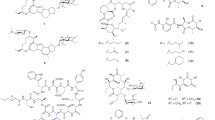Summary
Investment in combinatorial chemistry (combichem) in the pharmaceutical industry is being driven by the need for increased efficiency. Results from pioneers in the field have demonstrated where mixture or discrete compound synthesis is useful, and what mixture sizes and compound concentrations are appropriate. To make the techniques of combichem of general utility in drug discovery, a broad range of advances is still required. Conversion of organic chemistry to solid phase conditions is key, as are developments in linkers and resins. Library design methodology requires further development. Combinatorial biosynthesis of focused libraries of natural products holds great promise for capitalising on hardwon natural product leads. Miniaturisation of screens is required to reduce the cost of screening combinatorial libraries. Developments in the processes preceding and following synthesis are required to enable the flow of increased numbers of compounds without new bottlenecks developing. The impact of combinatorial chemistry will be greatly enhanced by synergy with ongoing parallel developments in genetic technologies, screening technologies and bioinformatics.
Similar content being viewed by others
References
Gallop, M.A., Barrett, R.W., Dower, W.J., Fodor, S.P.A. and Gordon, E.M.,Applications of combinatorial technologies to drug discovery. Part 1. Background and combinatorial peptide libraries, J. Med. Chem., 37 (1994) 1235–1251.
Gordon, R.M., Barrett, R.W., Dower, W.J., Fodor, S.P.A. and Gallop, M.A.,Applications of combinatorial technologies to drug discovery. Part 2. Combinatorial organic synthesis, library screening strategies and future directions, J. Med. Chem., 37 (1994) 1384–1401.
Geysen, M.H., Meloen, R.H. and Barteling, S.J.,Use of peptide synthesis to probe viral antigens for epitopes to a resolution of a single amino acid, Proc. Natl. Acad. Sci. USA, 81 (1984) 3998–4002.
Furka, A., Sebestyen, F., Asgedom, M. and Dibo, G, Abstr. Int. Congress Biochem. 14th, 1988, 5.47.
Seligman, B., Presentation at the IBC Symposium ‘Combinatorial Chemistry’, London, U.K., 1995.
Brown, D.,Lead discovery and optimisation through high speed chemistry, Presentation at the CHI symposium ‘Exploiting Molecular Diversity’, San Diego, CA, U.S.A., 1995.
Baldwin, J.J., Presentation at the CHI Symposium ‘Exploiting Molecular Diversity’, San Diego, CA, U.S.A., 1996.
Plunkett, M.J. and Ellman, J.A.,A silicon-based linker for traceless solid-phase synthesis, J. Org. Chem., 60 (1995) 6006–6007.
Peterson, M.L.,Automated strategies for high throughput synthesis: Methods and applications, Presentation at the CHI Symposium ‘Combinatorial Chemistry and High Throughput Screening’, Osaka, Japan, 1996.
Rhor, J.,Combinatorial biosynthesis — An approach in the near future?, Angew. Chem., Int. Ed. Engl., 34 (1995) 881–885.
Khosla, C. and Zawala, R.J.X.,Generation of polyketide libraries via combinatorial biosynthesis, ITBTECH, 14 (1996) 335–341.
Spencer, R., Presentation at the IBC Symposium on Combinatorial Chemistry, San Diego, CA, U.S.A., 1996.
Gaynor, G.H. (Ed.) Handbook of Technology Management, McGraw-Hill, New York, NY, U.S.A., 1996.
Author information
Authors and Affiliations
Rights and permissions
About this article
Cite this article
Brown, D. Future pathways for combinatorial chemistry. Mol Divers 2, 217–222 (1997). https://doi.org/10.1007/BF01715637
Received:
Accepted:
Issue Date:
DOI: https://doi.org/10.1007/BF01715637




